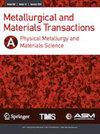失稳处理及其对高铬铸铁组织和基体硬度的影响
IF 2.2
3区 材料科学
Q3 MATERIALS SCIENCE, MULTIDISCIPLINARY
Metallurgical and Materials Transactions A-Physical Metallurgy and Materials Science
Pub Date : 2023-10-04
DOI:10.1007/s11661-023-07216-4
引用次数: 0
摘要
高铬铸铁是一类重要的耐磨材料,通常用于矿山和钢铁工业的耐磨应用。在热处理过程中,二次碳化物的类型及其形成顺序一直存在争议。本研究研究了含2.2 wt pct C和16.5 wt pct Cr的亚共晶高铬铸铁在失稳处理期间的组织演变。从由~ 28% m7c3共晶碳化物和马氏体和残余奥氏体混合基体组成的不均匀铸态组织开始,失稳处理导致基体中碳浓度接近平衡水平的接近均匀组织的建立。冷却后完全转变为马氏体。加热至失稳温度时,析出了均匀分布的m23c6次生碳化物,形貌为正方形,尺寸为100 ~ 500 nm。在较高的失稳温度下(1000℃),m7c3次生碳化物与m23c6一起形成,并通过明显不同的形态(拉长)来识别。基体碳含量是失稳温度和随后的共晶碳化物溶解的函数,它控制着马氏体的起始温度,并对体硬度起主导作用。本文章由计算机程序翻译,如有差异,请以英文原文为准。

Destabilization Treatment and Its Influence on Microstructure and Matrix Hardness of High-Cr Cast Iron
Abstract High-chromium cast irons are an essential class of wear-resistant materials commonly used for wear-resistant applications in the mining and steel industries. There is ongoing debate on the secondary carbide types and their formation sequences during heat treatment. This work examines the microstructural evolution during destabilization treatment of a hypoeutectic high-chromium cast iron containing 2.2 wt pct C and 16.5 wt pct Cr. Starting from an inhomogeneous as-cast microstructure consisting of ~ 28 pct M 7 C 3 eutectic carbide and a mixed matrix of martensite and retained austenite, destabilization treatments resulted in the establishment of near homogeneous structure with a near equilibrium level of carbon concentration in the matrix, which fully transformed to martensite upon cooling. Homogeneously distributed M 23 C 6 secondary carbides with a square-shaped morphology and 100 to 500 nm in size precipitated during heating up to the destabilization temperature. For higher destabilization temperatures (1000 °C), M 7 C 3 secondary carbides formed together with M 23 C 6 and were identifiable by a distinctly different morphology (elongated). It was found that the carbon content of the matrix, a function of the destabilization temperature and subsequent eutectic carbide dissolution, controls the martensite start temperature and has a dominating influence on bulk-hardness.
求助全文
通过发布文献求助,成功后即可免费获取论文全文。
去求助
来源期刊
CiteScore
5.30
自引率
7.10%
发文量
322
审稿时长
6 months
期刊介绍:
Metallurgical and Materials Transactions A focuses on the latest research in all aspects of physical metallurgy and materials science. It explores relationships among processing, structure, and properties of materials; publishes critically reviewed, original research of archival significance.
The journal address the main topics of alloy phases; transformations; transport phenomena; mechanical behavior; physical chemistry; environment; welding & joining; surface treatment; electronic, magnetic & optical material; solidification; materials processing; composite materials; biomaterials; and light metals. MMTA publishes Technical Publications, Communications, Symposia, and more.
Published with ASM International, The Materials Information Society and The Minerals, Metals & Materials Society (TMS)

 求助内容:
求助内容: 应助结果提醒方式:
应助结果提醒方式:


